I am simultaneously finishing a travel blog about the fantastic 4.5 month long trip Steven and I took last fall to Armenia, Georgia, Azerbaijan, and much of Central Asia before our final six weeks in Spain and Portugal and a few days in the Netherlands. If you're interested in checking that exciting adventure out, here's the link:
www.bergersadventures6.blogspot.com
Last summer when my recently widowed friend, Diane, talked about our getting away together for a few weeks, she expressed interest in touring both New Zealand and Australia. I told her that Steven and I had already visited much of Australia in 2015 but hadn't had time to see either the city of Melbourne, drive along the famous Great Ocean Road west of that city and also visit the island of Tasmania off the country's southeastern coast. I was thrilled when she said she'd be happy seeing just those areas on the Australian leg of our 3.5 week trip 'down under.'
Because of the terrorist attack in Christchurch two days earlier, we weren't able to catch our flight to Melbourne and spend the preceding day in the city seeing some of its amazing sights. We hoped to see at least something of the city when we returned from our few days exploring the sights along the Great Ocean Road (GOR) before heading to Tasmania. The GOR is one of Australia's, if not the world's, most famous drives; it hugs the windswept, rugged coastline just west of Australia's second most populous city. Though guidebooks recommended we take six days to fully take in the 562 mile road trip, Diane and I had less than half that time. After picking up the rental car in downtown Melbourne, we escaped the city via the Princes Freeway heading to Geelong, a lovely historic town located on the sparkling Corio Bay waterfront.
On the city green was a display of old cars that would have been more exciting for car buffs than it was for either of us.
By 1840 sheep and shepherd numbers had increased dramatically but a series of events created economic disaster. Three droughts, a depressed wool market and banks without money forced many graziers to declare bankruptcy. When a businessman realized in 1843 that tallow, used in making candles and soaps sold well in Britain, 'boiling down works' became popular in eastern Australia. Each sheep could yield seven shillings worth of tallow in addition to a skin or wool, bones and often two legs of mutton.
Grease, dirt and dried sweat salts are removed from the fleece by scouring. The wool is moved through a series of bowls and washed in a hot, detergent solution until it is finally rinsed and dried. Rakes move the wool along the bowl from the feed rollers to the squeeze rollers. A scouring train may consist of four or five bowls.
A sample of greasy wool was on the left; scoured wool was on the right and lanolin in the middle.
After scouring, wool fibers are still tangled so carding untangles them by brushing and straightening. Carding also removes any remaining burrs and grass seeds. The fibers emerge from the carding machine as a continuous, filmy web called a sliver. The sliver must be thinned and divided into strands before the next process called combing.
Wool can be dyed into a world of color. Wool fibers have a natural color ranging from white to shades of yellow and brown. Dyeing colors the wool by boiling it in a solution of dye and water. Wool can be dyed at different stages of its transformation - loose fiber, top, yarn, fabric and garment.
While dyes were first obtained from plants or animals, modern dyes are largely synthetic, chemical powders derived from coal and petroleum. Colors are produced mixing powders to exact recipes to ensure uniformity. Each textile mill has its own recipe books and dyeing specialists. The dual skills of dyeing and designing create a wide variety of colors and patterns to suit every taste.
This Manor House Rug was designed by Brinton's Carpets in 1990 exclusively for the National Wool Museum based on an earlier design from Brinton's UK Persian Rug Archive Library. The rugs are made from 80% wool and 20% nylon, the internationally preferred blend for high quality, long lasting carpets. Each yarn was threaded into a woven backing, creating a strong carpet that couldn't unravel with color to the core.
All along Eastern Beach at the Geelong waterfront were colorful and adorable bollards, sturdy, short, vertical posts that used to refer to a post on a ship or quay used principally for mooring boats. The word now is also used to refer to posts installed to control road traffic and posts designed to prevent car ramming attacks.
I remember Diane telling me both she and her children were familiar with the 'Adulting' term but I'd never heard it before. Have you?
On our way out of town we saw more of the city's charming historical buildings.
If we'd had more time, strolling through Johnstone Park would have been very enjoyable.
The world famous surf at Bells Beach came from faraway storms deep in the southern ocean. When the lines of swell from the south or southwest arrive, the rising shape of the sea floor and the underwater reefs cause the water to be lifted up into breaking crests, with just the right conditions for a great wave in the Bells bowl.
Point Addis Marine National Park, of which Bells Beach was a part, was part of a network of marine national parks and sanctuaries that protected about five per cent of the state of Victoria's marine environment from human disturbance. The park featured spectacular scenery above and below the water line. Offshore were limestone reefs filled with marine life including a wide range of fish and algae species, as well as seals, dolphins and brilliantly colored sponge gardens.
Recent archaeological evidence suggested that southeastern Australia has been inhabited for at least 70,000 years. Having survived the last Ice Age, the flooding of Bass Strait and volcanic eruptions across Western Victoria, the traditional cultures and lifestyles of the Koories - aboriginal people of SE Australia - changed with the arrival of Europeans over 200 years ago. About 1200 descendants of Victorian Koories still lived in the area and were working to recover and share more of their heritage.
The regular, controlled use of fire promoted the regeneration of important food plants and enabled animals that came to graze on the fresh shoots to be hunted more easily. It kept the country open, making movement easier.
Aireys Inlet was a very attractive coastal hamlet and was home to the historic Split Point Lighthouse known as the White Queen for its sensational 360 degree views. Built in 1891, the 34-meter high lighthouse was still operational but fully automated now.
Historians surmise that Buckley traveled with up to 25 clans of the Wathaurong people. I was interested to read that he later settled in Hobart in Tasmania - an island off Australia's southern coast Diane and I would travel to in a few days - where he held a minor government position from 1836 until his death in 1856.
The contrast between the rugged coast and the inland forest became even more spectacular although that was hard to believe that was even possible.
www.bergersadventures6.blogspot.com
Because of the terrorist attack in Christchurch two days earlier, we weren't able to catch our flight to Melbourne and spend the preceding day in the city seeing some of its amazing sights. We hoped to see at least something of the city when we returned from our few days exploring the sights along the Great Ocean Road (GOR) before heading to Tasmania. The GOR is one of Australia's, if not the world's, most famous drives; it hugs the windswept, rugged coastline just west of Australia's second most populous city. Though guidebooks recommended we take six days to fully take in the 562 mile road trip, Diane and I had less than half that time. After picking up the rental car in downtown Melbourne, we escaped the city via the Princes Freeway heading to Geelong, a lovely historic town located on the sparkling Corio Bay waterfront.
Buildings from the city's boom days of the gold rush era and thriving wool industry had been converted into swanky bars and restaurants.
Walking toward the National Wool Museum, we passed by Sailors Rest, a memorial to "Our Late King Edward VII." The cornerstone was laid by the state's premier in 1912.
Nearby was the 1877 statue of Prince Albert Edward.
The National Wool Museum was located in one of the city's former wool store buildings, dated from 1872 and was made of bluestone, something I'd not heard of before. The building was considered a masterpiece of the time and was a forerunner in design for wool stores around the world.
For more than a century, Geelong was the heart of the Australian wool industry. With its wool stores, textile factories and wool scours to rid wool of its impurities, the city's history was in many ways also a story of wool. Geelong's reputation as a textile town dated to 1865 when the state's first woolen mill was established on the banks of the Barwon River.
When it came to celebrate the country's 100th anniversary in 2001, Geelong chose the sheep to represent its past. Modeled on a 1951 float, the float was a giant sheep that measured about 25' long and covered in 13,000 flowers! This sheep's head on display was covered with 'just' 5,000 flowers.
The photo showed a whopping 75,172 Merino sheep mustered for shearing in 1988. All I could think of who was responsible for counting all those sheep!
On the fence were written sayings we're all familiar with but don't necessarily associate with sheep rearing: pulling the wool over your eyes, by hook or by crook, making sheep's eyes, dyed in the wool, fleecing the customers, and on tenterhooks. My favorite, Steven, was "There'll never be another ewe!"
The first sheep farmers came to Australia as free settlers, ex-convicts or wealthy landowners. Whatever their background, the common aim was to transform this ancient land into another Europe.
They soon found out, however, that tried and true sheep practices that worked there often failed in their new homeland. Seasons were reversed, vegetation was different, unknown diseases struck the sheep and old fashioned remedies didn't work. It was only when traditional methods were abandoned or were adapted to the new continent's potential that the wool industry began to flourish.
Merino sheep make up for about 80% of Australia's total sheep population. The breed has thrived due to its ability to cope with the conditions. The Merino sheep that were introduced soon after settlement produced a fleece of 1.5-2 kilos per animal. Nowadays, a Peppin Merino stud ram may produce a fleece of up to 18 kilos or more! Record Merino prices peaked in the 1980s when a Merino ram secured $450,000 at the 1989 Royal Adelaide Show ram sales!
I had never known, or probably thought much about, the fact that different wool is grown for different purposes. The fleece's market value is dependent on its fineness, length, strength and cleanness. The first thing wool buyers judge is fineness which is measured in microns.
Because the length and strength of wool fibers varies in different brands of sheep, this determines how the wool is used. Sock, for instance, are made from short staple lengths while longer and stronger staples are used for finer fabrics. Not surprisingly, a fleece's condition affects the price paid. Sheep pick up all sorts of things in their fleeces as they graze.
Traditionally wool sheds were claimed as the domain of men. It was amusing to learn that in the past men would utter the phrase "ducks on the pond" as a cryptic warning to other male shearers that there were women in the sheds and they should watch their language and clean themselves up! Over time, this segregation changed so that in recent years, the role of women has increased dramatically across all aspects of the wool industry, but most significantly in wool sheds.
A photographic display included portraits that celebrated the significant role of women in the industry and showed women ranging in age from 19 to 96 who were both young female shearers and experienced workers.
I liked watching a video of a female shearer doing her job! I was surprised how calm the sheep was during the process.
A carpet factory was established in Geelong in 1960 because of the city's long tradition of textile production. The city is now famous for its quality wool, fabric and carpet production. The museum had a massive gripper-type Jacquard Axminster carpet loom from 1910 that was still turning out carpets. The process took its name from Axminster in England where hand-knotting of carpets was commonly developed in the 18th century.
The loom, with its 1,323 bobbins and 1,992 punch cards, could weave up to seven colors at a time and was fitted with a Jacquard system that could make complex designs and patterns. We were lucky enough that our visit coincided as a staffer operated the machine to continue making a custom 27" wide by 33 foot long hall runner using 7 colors and 189 grippers! The cost for such a long runner was $AUD1400 or USD 1400.
Darlene: You'd have loved seeing this ancient loom in operation!
In 1894, the Scottish Australian Heritage Council held a national competition to design an Australian tartan. The winner was a Melbourne architect who based the colors of his design on the warm Australian landscape. The colors he chose were superimposed on the pattern of the Macquarie Settlement named for the first Scottish person to be civil governor of the colony of New South Wales from 1810-1821.
Who knew there was such a thing as a Sheep to Suit Competition?! This three-piece suit and tie was created as part of the competition's world record attempt in 1982. The Melbourne College of Textiles created the suit in a world record time of just one hour, 34 minutes and 33.52 seconds! In that time, the team shore three sheep, carded, spun and wove the fleece into cloth. The cloth was then cut and sewn into this suit!
Using the museum's restroom was the second time that day we came across a dispenser for contaminated needles. We wondered whether this part of Australia had a major problem with drug addicts as it was somewhat disconcerting seeing the dispenser in the museum.
As we walked toward the city's waterfront, I couldn't understand the 2017 sculpture's name Me, Myself and I Phone as I saw no evidence of an I Phone on the figure created by Anne Anderson.
These bollards took on the look of male lifeguards!
What a hoot seeing people going out on camel rides along the beach! It felt, Steven, like you and I were back in the Middle East.
One of the last stores I expected to see in Australia was Target. Anytime Fitness also had some locations in Geelong.
If we'd had more time, strolling through Johnstone Park would have been very enjoyable.
Geelong City Hall:
Sunday was a fun day to visit Geelong as there was lots going on in and around the city. If I were ever to return, I'd like spending more than a few hours in the city as there was more to take in apart from the interesting National Wool Museum and waterfront.
Back on the Surf Coast Highway, we stopped off at Bells Beach near Torquay, the powerful point break that is part of international surfing folklore. It has held Australia's premier surfing event, the Bells Classic, since 1973. It was here that Keanu Reeves and Patrick Swayze had their ultimate showdown in the film Point Break.
Surfing wasn't for the fainthearted if you believed the sign that cautioned against the large breaking waves, strong currents, submerged rocks, slippery rocks and also unstable cliffs! As well as being a magnet for surfers, the waves that crashed onto Bells Beach nourished sea life by carrying much needed food and oxygen in their turbulent froth.
After walking the cliff path, we watched surfers for a good while at Winki Pop Beach. I had never realized how much time surfers spend just waiting for a wave. It was easier to focus on this surfer the whole time because his lime green suit was more visible in the sea of black-clad surfers. It was surprisingly enjoyable watching the surfers, probably because we kept waiting and hoping some of the surfers would catch a big wave and ride it into shore.
The intertidal limestone reefs were some of the most bio-diverse along the Surf Coast. Over 75 species of invertebrates have been recorded at Point Addis. The shallow rocky reefs supported extensive kelp forests that provided shelter for fish.
There were lots of signs warning people walking along the cliff-side path to stay clear of the unstable cliffs. Someone had also written that this was always aboriginal land.
A few miles away from the spectacular Point Addis was a turnoff for both Southside Nude Beach and the Koorie Cultural Walk. In case you're wondering, we were more interested in the latter! The 2km trail detailed how the indigenous Wathaurong people lived there for millennia.
Koories had a regular pattern of movement within their territory that was dictated by the seasonal abundance of food, revisiting the same campsite every one to two years. Each site was on high ground but near reliable sources of food, fresh water with shelter from prevailing winds. Sand was spread out like a carpet and temporary bark slab huts were erected in poor weather.
This design resented a Possum Skin Cloak. Possums were hunted in the forest for their meat and skin and then dried and cleaned using the sharpened edge of a mussel shell. Sinews from the tail and a bone bodkin were then used to sew up to 30 skins together. As the sinew dried and shrank, the skins pulled tightly together to form a warm, waterproof cloak that was worn across the shoulder.
The vegetation was so very different here than what we'd just seen when leaving New Zealand yesterday where we'd come across so many rainforests and everything appeared to be so lush and green. Here, the land seemed bone dry by contrast. We saw evidence of a recent fire but didn't know if it'd been a controlled burn or had occurred naturally.
The leaves of the Austral Grass Tree produced a hard waterproof resin used to cement stone ax heads and spear tips to their wooden handles. Pieces of the dried flower stalk were used as a base on which a branch of Austral Mulberry Bush was rubbed to start a fire quickly and easily. The flower produced a sweet-tasting nectar and the young leaves and roots were eaten.
Never had I seen a grass tree before! The cultural walk had been really interesting and was unlike any walk I remember being on before.
The lovely Addiscott Beach was part of the Koorie Cultural Walk which was also part of the Great Otway National Park.
A short drive further on was the Otway Coastal Reserve where we stopped for a bit. By this part of our drive along the Great Ocean Road, I could certainly see how it could easily take six days to fully enjoy the scenic drive as there were gorgeous and fascinating places to stop every few miles!
Huh??
I asked this man with the motor on his back what the thingamajigs above were and he said, "Somebody on drugs did that!" Not very helpful but amusing. I guess I should have asked the question of someone other than a man with a motor on his back! I didn't ask him what he was doing with the motor but I was sorely tempted!
I know this was sort of heron but whether it was a blue heron or a white one, I had no clue. If anyone knows for sure, let me know please so I can edit this post.
On the advice of the tourism official in the National Wool Museum in Geelong, we detoured off the GOR to drive inland to the Anglesea Golf Course to see if we could view any kangaroos. You can see by the photos below that we were in luck!
This kangaroo stared at me for the longest time as I took some photos.
After that fun stop, we headed toward Split Point Lighthouse. This part of the GOR drive was full of Surf Coast Walks.
We stopped first at Urquhart Bluff Beach where the strong smell of seaweed reminded me of dulse, a well known snack food, my father used to love chomping on whenever we were back visiting his side of the family in his hometown of Saint John, New Brunswick.
A pretty hard hitting safety sign, I thought.
This beach was also a huge draw for surfers.
I wonder if Sunday was the only day when car buffs liked to show off their old vehicles.
Much of the information about the local indigenous people was taken from the accounts of William Buckley who was born in England in 1780 and was transported to Australia in 1803 after being convicted of a crime. He received a pardon in 1835 and spent much time traveling along the coast. His survival was dependent on the teachings and kindness of the local Koorie people.
The walk up to the lighthouse wasn't very taxing. What a shame that we were just a few minutes late to climb the 136 steps to its top so we could take in the gorgeous views.
Photos near the lighthouse:
It was heartwarming that someone had put up a sign saying "We respect the traditional ancestors of this land." I can't think of a place here in the US that indicates in writing that same level of respect for our own native people.
We needed to make a final push for the town of Apollo Bay where we had reservations to stay the night.
You can see where the road would take us.
Just as had been the case in New Zealand, we also saw quite a few comparable signs reminding foreigners which side of the road to drive on.
After we left the lighthouse behind, the road took us away from the stunning ocean views - sigh! - to much hillier terrain.
If it hadn't already been after 5, Diane and I would have loved to stop for a drink at the Great Pacific Hotel in the seaside town of Lorne as it was so appealing.
Lorne was at the foot of the lush Otway Ranges.
If you look closely or click to enlarge the photo, you can see the road we'd be taking as we drove along the coast later that afternoon.
We stopped briefly to get a sense of the stretch of road we'd just come along that hugged the cliffs and the sea.
The contrast between the rugged coast and the inland forest became even more spectacular although that was hard to believe that was even possible.
What a wonderful day we'd had enjoying just a small stretch of the famous Great Ocean Road taking in first charming Geelong, then just a few of the many cliff side walks while admiring the beaches that attract so many surfers and the very different cultural walk. Though we'd only driven about 300 kms that day, we were both pretty tired still from the long day the previous day getting to Melbourne from Christchurch and then stopping every 20 minutes or so after driving for an hour to Geelong and then an hour at the end of the day without our customary coffee or lunch stop.
Next post: Continuing along the Great Ocean Road to Otway Fly and the 12 Apostles.
Posted on May 11th, 2019, from our home in Denver's suburbs.
















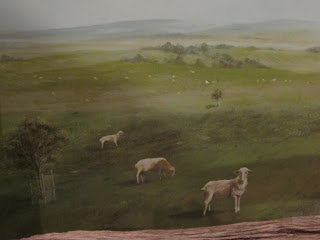
































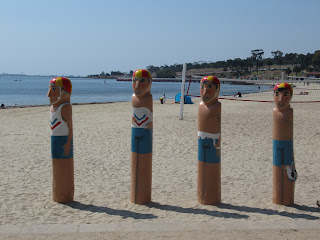























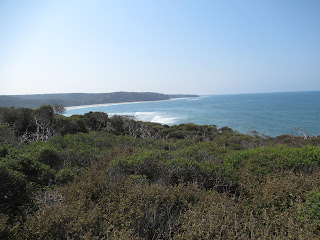

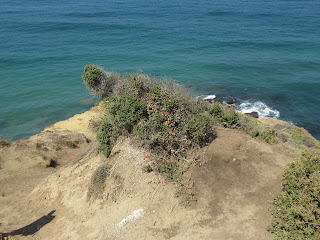






















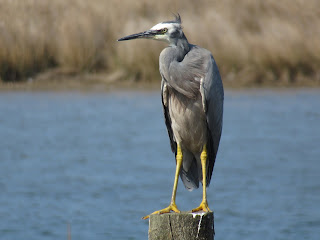





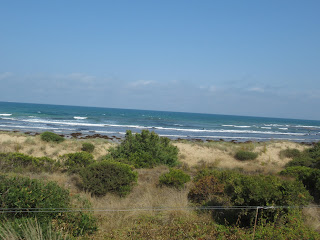


























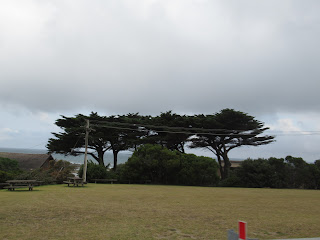






No comments:
Post a Comment